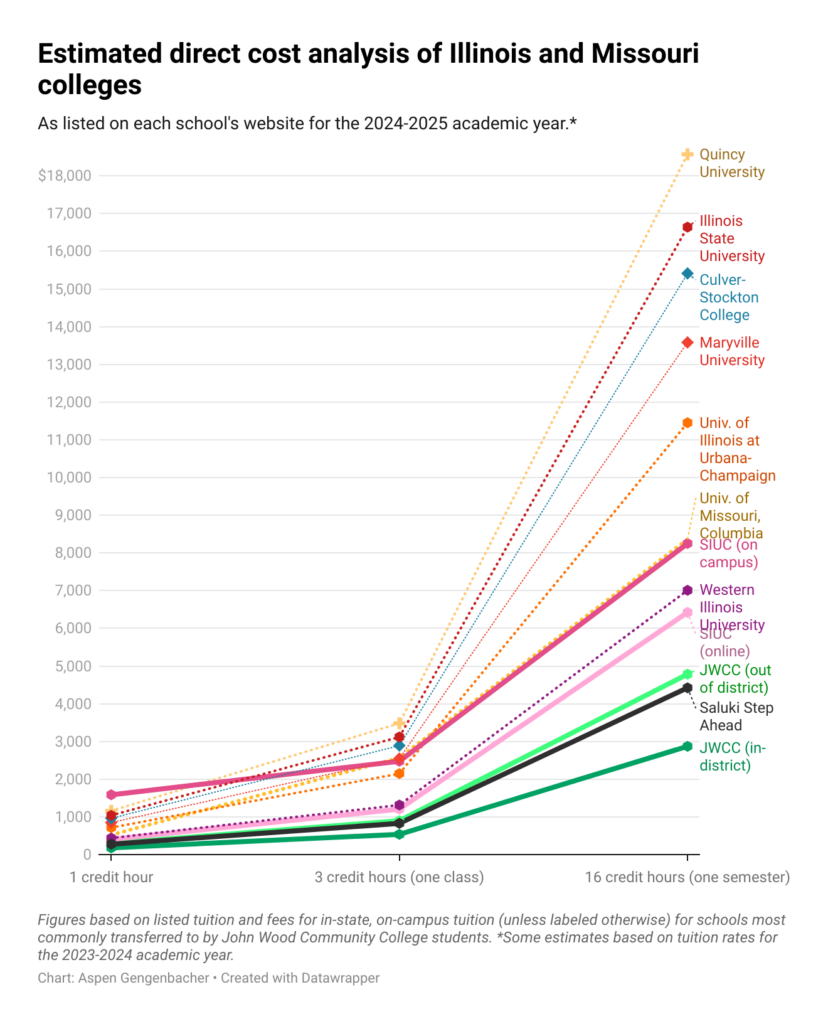New program from JWCC and SIUC allows students to ‘become Trailblazers and Salukis at the same time’

QUINCY — The John Wood Community College Trailblazers and Southern Illinois University-Carbondale Salukis finalized an agreement Wednesday afternoon, as leaders from both institutions presented a program enabling JWCC students to continue their educational careers at SIU-C online and at a lower cost.
JWCC President Bryan Renfro and SIUC Chancellor Austin A. Lane shared a few laughs, a couple of sarcastic comments about the lovely 89-degree fall weather Illinois has been having and a handful of “Do you know so and so?”s before signing an agreement for the Saluki Step Ahead program in a virtual ceremony. It was a very midwestern, albeit modern, affair.
With Renfro stationed at the college’s 1302 S. 48th campus and Lane situated four hours south in Carbondale, it was also representative of the convenient and community-minded nature of the program itself.
“(Students) don’t have to come to Carbondale (four) hours away,” Lane said. “They can stay right there with you and not upset your economic development that’s happening in Quincy … We’re excited to have this partnership.”
JWCC is the 45th college to join the Saluki Step Ahead program, which launched in 2021. The partnership offers 12 online programs through SIUC and $8,000 in scholarships to qualified students wanting to pursue their bachelor’s degree in a convenient and cost effective manner.
Saluki Step Ahead aims to save students time and money
With extensive backgrounds in leadership positions at various institutions of higher education, Renfro and Lane share an understanding of what their students need and how to help them achieve their goals.
“It doesn’t surprise me that someone with a community college background (and) understanding … was involved in crafting (the program), so we appreciate that here,” Renfro said. “For us, it’s about creating as many different opportunities for our students that we can. We know some of them may want to come there (to Carbondale), but some of them may want to stay here (in Quincy). Either way, we know that they’re getting a quality education at Southern Illinois University-Carbondale.”
Students must graduate with their associate’s degree from a partnered institution with at least a 2.0 GPA to qualify for the program. To maximize cost efficiency, students should apply for the program during their first year at JWCC. Doing so ensures students won’t take classes they don’t need to obtain their bachelor’s degree.
Most programs require 60 credit hours to be completed to obtain an associate’s degree and an additional 60 credit hours of program-specific courses to obtain a bachelor’s degree, resulting in 120 credit hours total by the time a student graduates. But Lane said transfer students from community colleges often arrive at four-year institutions with far more credit hours than needed.
“The financial piece is critical because … community college students are coming with maybe 70, 80, 90 hours, when it doesn’t take that many hours at all. They’re graduating with us at 150 (credit hours), so we want to cut that way down,” Lane said. “The way to do that is to put them on a pathway as soon as they get to John Wood. They can make their decision to sign with us and be done in four years — if not sooner.”
Are a few extra credit hours really that expensive?
According to tuition estimates based on the 2023-2024 academic year, the cost of tuition and fees for one 3-credit hour class at JWCC can range from roughly $540 to $900, depending on if the course is online or in person and if a student is from inside or outside of John Wood’s 2,400 square-mile district.
Tuition estimates for the fall 2024 semester at SIUC estimate the cost of tuition and fees for one 3-credit hour course at SIUC to range from about $1,200 to $2,475, depending on if a student is online or in-person. By these figures, an extra semester’s worth of unnecessary courses can cost a student anywhere from $2,870 to $8,250.
Simply put: yes, especially without any grants or scholarships, unnecessary credit hours really are that expensive.

Creating opportunities, from Quincy to Carbondale
In addition to the convenience of online programs and the obvious financial benefits of lower overall costs, the programs hail from an institution with robust research initiatives spanning several disciplines. The university is categorized as an R-2 doctoral research university indicating “high research activity.” It was recognized by The Princeton Review as one of the best colleges in the Midwest for 2025.
Eligible students can choose from 12 online academic programs to complete their bachelor’s degree:
- accounting;
- business administration;
- criminology and criminal justice;
- early childhood;
- elementary education;
- healthcare management;
- history;
- industrial management and applied engineering;
- information technology;
- nursing (RN to BSN);
- psychology;
- and radiologic sciences.
“We put our Saluki Step Ahead in place really as a way to put our flag in the ground to be one of the most transfer-friendly institutions in the state,” Lane said. “(SIUC) is focused on… making sure (transfer students) continue their hours to count towards their degree and not just the transcript.”
The Saluki Step Ahead program is one of several ways SIUC seeks to appeal to transfer students. The institution has articulation agreements with 544 colleges, including JWCC, that guarantee students’ credits will be successfully transferred to SIUC. Agreements incorporate specific courses at individual junior colleges and SIUC into program-specific degree plans and comprehensive transfer guides. The university also has its AIM High/Saluki Commitment, which covers whatever costs not covered by a qualifying student’s financial aid package for four consecutive semesters for transfer students.
Three of four JWCC students are planning on transferring to four-year colleges after obtaining their associate’s degree, according to a press release regarding the JWCC University Transfer Center, which opened in the spring.
Quincy native Alayna Schmoe, a sophomore at JWCC studying communications, is one of those students.
“I plan to transfer to a four-year university,” she said. “Go study there, maybe get my masters.”
The location and price helped Schmoe choose to attend JWCC before moving to a larger school. Though she had to take out loans for her first year of classes, she obtained a full-ride scholarship for the 2024-25 school year.
“I never really thought about — until I got to college — how much it really does cost to go to college,” Schmoe said. “So definitely being here, I understand how cost-effective … the programs that we have here at John Wood are, because they offer great classes and everything like that for a really reasonable rate.”
‘Imagining’ a new path forward for SIUC
The Education Data Initiative estimates that “the average public university student borrows $32,362 to attain a bachelor’s degree,” making programs that incentivize students with significant cost cuts, like the Saluki Step Ahead, attractive to students.
Enrollment at SIUC had been steadily declining since reaching a peak of almost 25,000 students in the fall of 1991. The university announced this fall that, for the first time in over 20 years, enrollment has risen for two years in a row. The recent rebound can be attributed to the university’s Imagine 2030 plan, launched in November 2021, which identified five pillars of focus that served as a guide for strategic planning:
- student success and engagement;
- diversity, equity and inclusion;
- branding and partnerships;
- research and innovation; and
- sustainability.
The latest enrollment numbers show the university is on track to meet yet another one of the plan’s objectives: to reach an enrollment of 15,000 students by 2025.
With a 111 percent annual enrollment increase in the Saluki Step Ahead program as of this month, a pack of Trailblazers could assist in the attainment of that goal.
“(Students) become Trailblazers and Salukis at the same time,” Lane said. “When they walk onto the John Wood campus, they can really exhale knowing they’re Salukis while they’re going to John Wood and that in two years, they’re going to be right on track to finishing their degree.”
Students interested in the Saluki Step Ahead program can apply here. The general application for undergraduate students, which is free to submit until Oct. 31, can be found here.
Miss Clipping Out Stories to Save for Later?
Click the Purchase Story button below to order a print of this story. We will print it for you on matte photo paper to keep forever.

